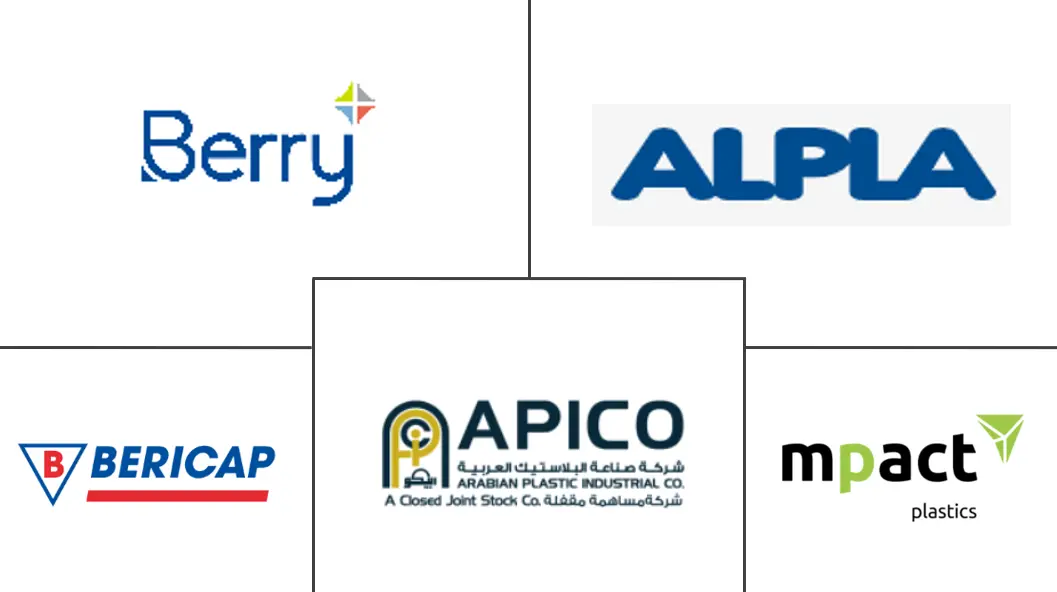Middle East And Africa Plastic Bottles Market Size and Share
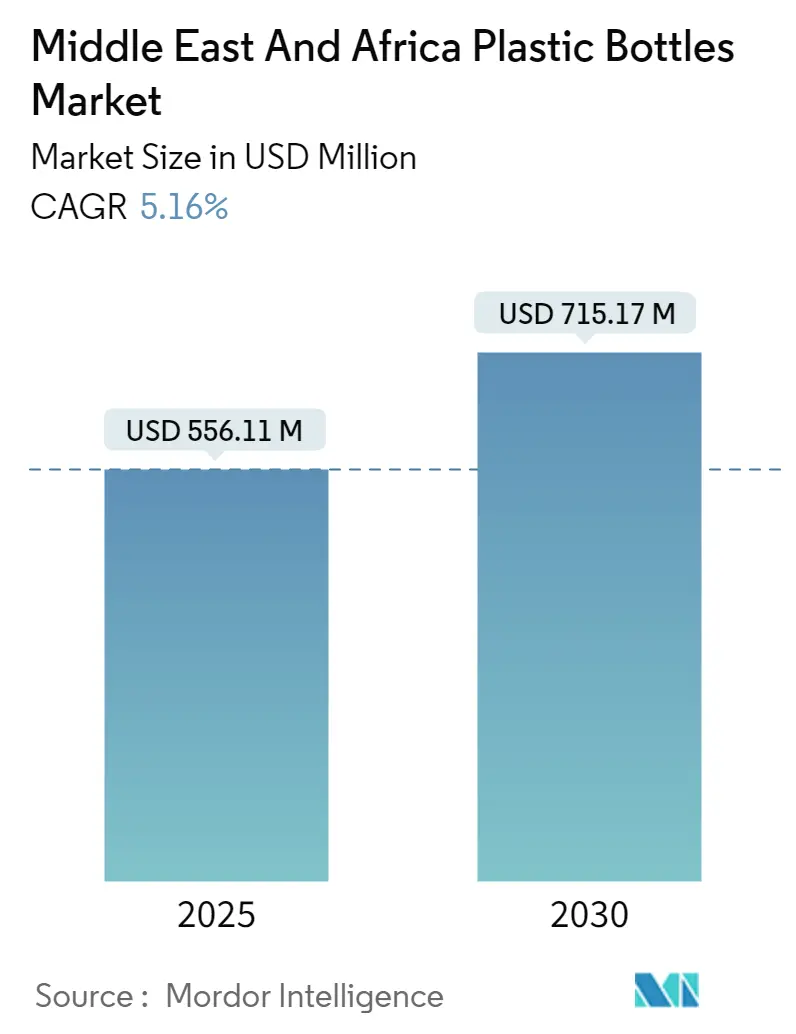
Middle East And Africa Plastic Bottles Market Analysis by Mordor Intelligence
The Middle East And Africa Plastic Bottles Market size is worth USD 556.11 Million in 2025, growing at an 5.16% CAGR and is forecast to hit USD 715.17 Million by 2030.
- According to the Economic Research Forum, the Middle East and North Africa experienced a modest growth of 1.9% in 2023, with projections for 2024 at 2.7%. Factors such as a burgeoning population, heightened urbanization, and a surge in tourism, especially in the United Arab Emirates, Saudi Arabia, and South Africa, are driving the region's packaging industry.
- With the rapid expansion of the food retail industry, there is a corresponding increase in the demand for plastic bottles. Data from the United States Department of Agriculture (USDA) highlights that Saudi Arabia's food retail sales hit around USD 58 billion in 2023, with a projected growth of about 4% in 2024. This robust expansion has spurred major retailers to broaden their horizons.
- In 2023, the United Arab Emirates saw a notable uptick in tourism, largely fueled by an influx of meetings, conferences, and exhibitions. Coupled with this, the United Arab Emirates's food e-commerce retail sales touched USD 1.07 billion in 2023, further amplifying the demand for plastic bottles.
- Regional giants such as Alpla Group and Berry Global Inc. are doubling down on sustainability, focusing on plastic recycling and the use of post-consumer recycled plastic (PCR) in their products. A testament to this commitment, in May 2024, Alpla Group, an Austria-based manufacturer with a significant presence in the Middle East, forged a partnership with Re-Purpose, channeling a hefty EUR 60 million (USD 65.96 million) into a new recycling plant in South Africa. This facility is expected to charge over 35,000 tonnes of recycled PET (rPET) each year.
- However, the region grapples with mounting environmental concerns surrounding plastic bottle waste, posing a significant hurdle to market growth. As consumerism swells and the population expands, the challenge of plastic waste looms larger, especially with increasing leaks into the environment, thus hampering the market growth.
Middle East And Africa Plastic Bottles Market Trends and Insights
The Beverage Segment is Expected to Dominate the Market
- As per the United States Department of Agriculture (USDA), Saudi Arabia's burgeoning population, an expanding food retail industry, a developing food processing industry, and a robust foodservice industry, supported by a burgeoning tourism industry and an influx of religious pilgrims to Makkah and Madina are driving the region's demand for non-alcoholic beverages.
- The United Arab Emirates, with its strategic location, strong infrastructure, and business-friendly policies, has become a key player in the global food and beverage trade. This has helped regional and international food and beverage flows, strengthening the UAE's industry. Because a significant portion of the population restricts alcohol consumption due to cultural and religious beliefs, the non-alcoholic beverages segment is expected to grow significantly in the region.
- Countries, including Saudi Arabia, the United Arab Emirates, and South Africa, are witnessing a pronounced shift toward healthier beverage preferences. This trend has spurred a rising demand for low-calorie drinks and an increased appetite for plastic bottles. In this region, a growing preference for healthy, non-alcoholic beverages and over-caffeinated and sugary ones is further fueling market expansion.
- The surge in bottled water consumption across the region is driven by a heightened demand for safe drinking water and a growing interest in functional and premium bottled varieties, largely due to tourism. Data from the Beverage Marketing Corporation (BMC) indicates that bottled water consumption in the United Arab Emirates rose from 36.6 gallons in 2022 to 37.5 gallons in 2023.
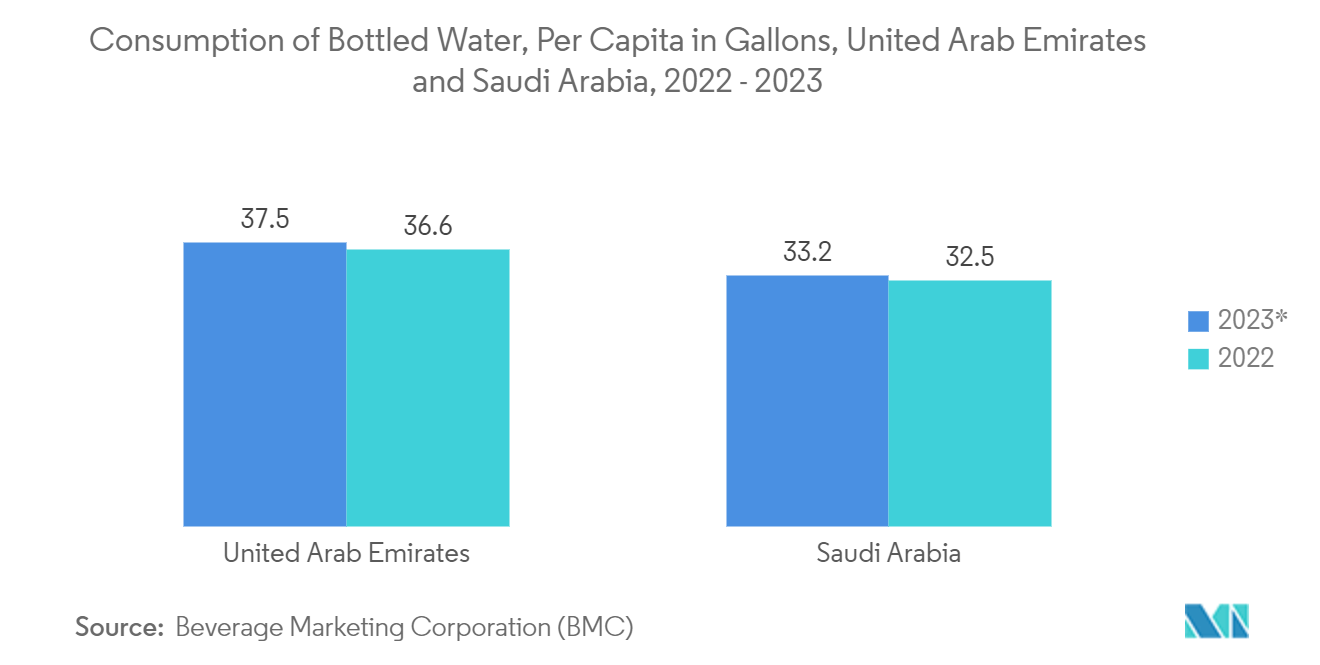
Saudi Arabia is Expected to Hold Highest Market Share
- As reported by the United States Department of Agriculture (USDA), Saudi Arabia is one of the world's wealthiest nations. In 2023, the nation's GDP hit USD 1.11 trillion, making it the 15th-largest economy globally and the dominant economic force in the Middle East. With a high per-capita income and robust purchasing power, a rising demand for healthier food and beverage choices is boosting the country's appetite for plastic bottles.
- Saudi Arabia's surging consumption of non-alcoholic beverages, including juices, soft drinks, and energy drinks, can be linked to its growing population and increased retail outlets. The retail industry's expansion, driven by major players like LuLu, Tamimi, Panda, and Danube, has fueled beverage sales.
- In the Middle East and Africa (MEA), the beauty and personal care industry is growing, with Saudi Arabia emerging as a key contributor. This surge is notably seen in the rising sales of skincare and haircare products. A report from the Chalhoub Group highlights that Saudi consumers lead the Middle East in beauty product expenditures. Additionally, the growing e-commerce industry in Saudi Arabia is expected to drive market growth in the coming years.
- Data from the USDA reveals that Saudi Arabia relies on imports for 70% of its food needs. The nation sources its consumer-oriented products predominantly from Brazil (7%), the United Arab Emirates (6%), Egypt (6%), and the United States (5%), stimulating the domestic market.
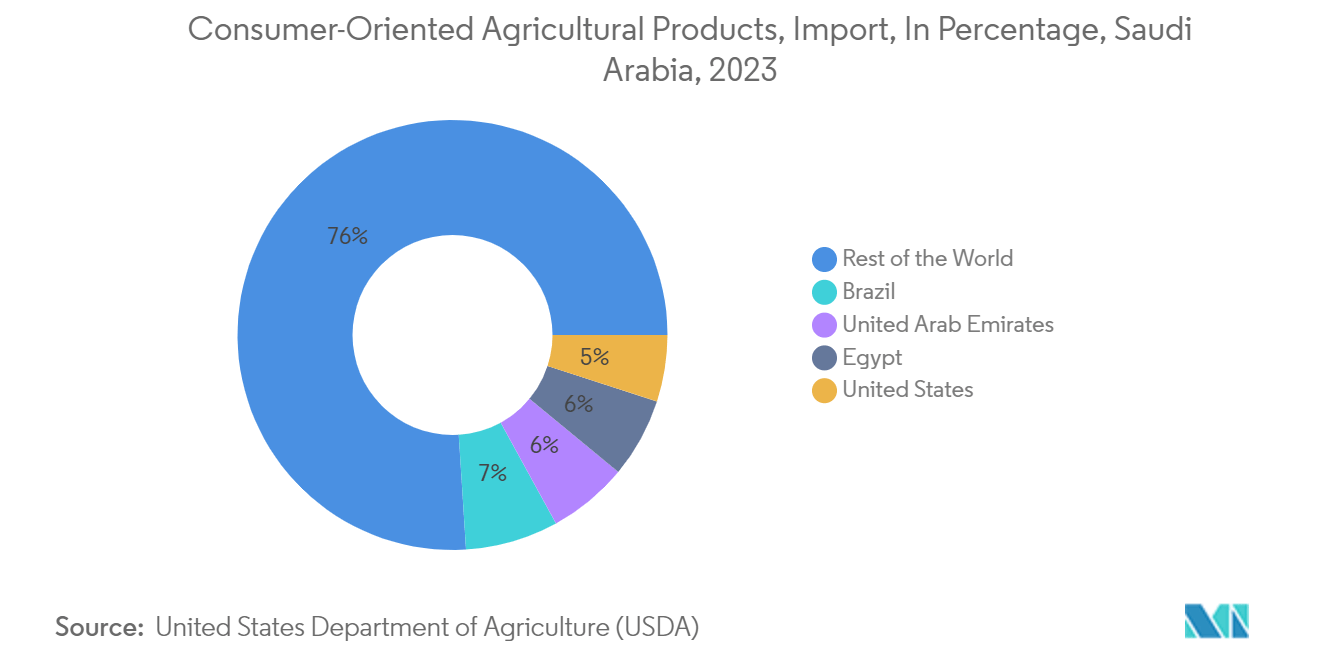
Competitive Landscape
Key players, such as Alpla Group, Bericap Holding GmbH, Arabian Plastic Industrial Co. (APICO), and Mpact Group, moderately consolidate their dominance in the Middle East and African plastic bottles market. These players are strengthening their positions through new product development, partnerships, mergers and acquisitions, and expansions.
June 2024: Arabian Plastic Industrial Co. (APICO), based in Saudi Arabia, inaugurated its new factory in Al-Kharj Industrial City, covering 34,000 square meters. This strategic move marks a major milestone for the company, which aims to strengthen its market presence by expanding its plastic product portfolio across industries like food and retail.
May 2024: Alpla Group, an Austria-based company with operations in the Middle East, unveiled a recyclable PET wine bottle. Weighing in at 50 gm, the 0.75-liter bottle is approximately eight times lighter than its glass counterpart. The company has ambitious plans, targeting the production of several million units annually from 2025, focusing on solutions crafted entirely from rPET.
Middle East And Africa Plastic Bottles Industry Leaders
Alpla Group
Berry Global Inc.
Arabian Plastic Industrial Co.
Bericap Holding GmbH
MPact Group
- *Disclaimer: Major Players sorted in no particular order
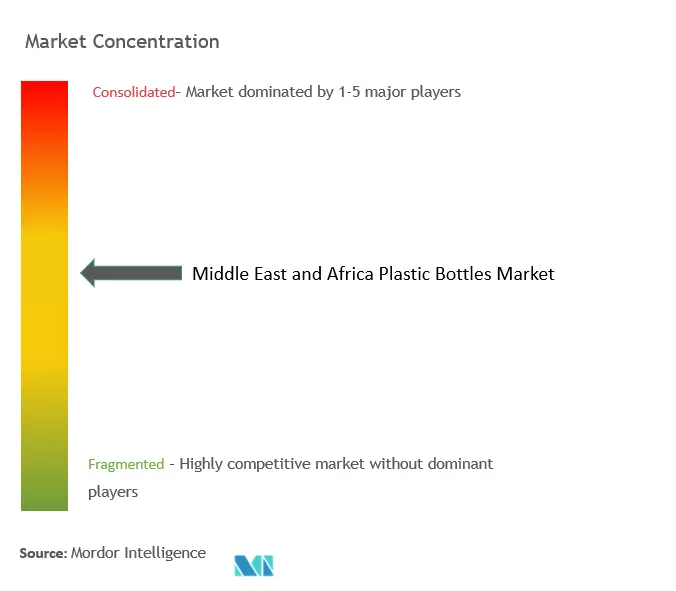
Recent Industry Developments
- November 2023: Mpact Group, a South Africa-based company, secured a gold medal at the IPSA Gold Pack Awards for its innovative polyethylene terephthalate (PET) bottle design, which utilizes the integrated molded handle (IMH) technology. This advanced bottle has high chemical resistance and caters to personal, chemical, and home care markets.
- November 2023: PepsiCo, a US-based beverage company, rolled out bottles made entirely from recycled plastics for its flagship brands, like Pepsi, Diet Pepsi, and Pepsi Zero, in the United Arab Emirates. These newly introduced bottles are engineered to produce over 30% fewer greenhouse gas (GHG) emissions than their conventional PET counterparts.
Middle East And Africa Plastic Bottles Market Report Scope
The scope of the study characterizes the plastic bottles market based on the raw materials of the product, including PP, PE, PET, and other raw materials used across various end-user industries such as food, pharmaceuticals, beverages, personal care, toiletries, and more across various countries. The research also examines underlying growth influencers and significant industry vendors, all of which help to support market estimates and growth rates throughout the anticipated period. The market estimates and projections are based on the base year factors and arrived at top-down and bottom-up approaches.
The Middle East and African plastic bottles market is segmented by resin (polyethylene (PE), polyethylene terephthalate (PET), polypropylene (PP), and other resins), end-user industries (food, beverages (bottled water, carbonated soft drinks, alcoholic beverages, juices and energy drinks, and other beverages (powdered and dairy-based beverages), pharmaceuticals, personal care and toiletries, household chemicals, paints and coatings, and other end-user industries), and geography (Saudi Arabia, United Arab Emirates, South Africa, Egypt, Nigeria, Morocco, and the Rest of Middle East and Africa). The market sizes and forecasts are provided in terms of value USD) and volume (tonnes) for all the above segments.
| Polyethylene (PE) |
| Polyethylene Terephthalate (PET) |
| Polypropylene (PP) |
| Other Resins |
| Food | |
| Beverage | Bottled Water |
| Carbonated Soft Drinks | |
| Alcoholic Beverages | |
| Juices and Energy Drinks | |
| Other Beverages (Powdered and Dairy-based Beverages) | |
| Pharmaceuticals | |
| Personal Care and Toiletries | |
| Industrial | |
| Household Chemicals | |
| Paints and Coatings | |
| Other End-user Industries |
| United Arab Emirates |
| Saudi Arabia |
| Egypt |
| South Africa |
| Nigeria |
| Morocco |
| By Resin | Polyethylene (PE) | |
| Polyethylene Terephthalate (PET) | ||
| Polypropylene (PP) | ||
| Other Resins | ||
| By End-user Industries | Food | |
| Beverage | Bottled Water | |
| Carbonated Soft Drinks | ||
| Alcoholic Beverages | ||
| Juices and Energy Drinks | ||
| Other Beverages (Powdered and Dairy-based Beverages) | ||
| Pharmaceuticals | ||
| Personal Care and Toiletries | ||
| Industrial | ||
| Household Chemicals | ||
| Paints and Coatings | ||
| Other End-user Industries | ||
| By Geography | United Arab Emirates | |
| Saudi Arabia | ||
| Egypt | ||
| South Africa | ||
| Nigeria | ||
| Morocco | ||
Key Questions Answered in the Report
How big is the Middle East And Africa Plastic Bottles Market?
The Middle East And Africa Plastic Bottles Market size is worth USD 556.11 million in 2025, growing at an 5.16% CAGR and is forecast to hit USD 715.17 million by 2030.
What is the current Middle East And Africa Plastic Bottles Market size?
In 2025, the Middle East And Africa Plastic Bottles Market size is expected to reach USD 556.11 million.
Who are the key players in Middle East And Africa Plastic Bottles Market?
Alpla Group, Berry Global Inc., Arabian Plastic Industrial Co., Bericap Holding GmbH and MPact Group are the major companies operating in the Middle East And Africa Plastic Bottles Market.
What years does this Middle East And Africa Plastic Bottles Market cover, and what was the market size in 2024?
In 2024, the Middle East And Africa Plastic Bottles Market size was estimated at USD 527.41 million. The report covers the Middle East And Africa Plastic Bottles Market historical market size for years: 2019, 2020, 2021, 2022, 2023 and 2024. The report also forecasts the Middle East And Africa Plastic Bottles Market size for years: 2025, 2026, 2027, 2028, 2029 and 2030.
Page last updated on:
Middle East And Africa Plastic Bottles Market Report
Statistics for the 2025 Middle East And Africa Plastic Bottles market share, size and revenue growth rate, created by Mordor Intelligence™ Industry Reports. Middle East And Africa Plastic Bottles analysis includes a market forecast outlook for 2025 to 2030 and historical overview. Get a sample of this industry analysis as a free report PDF download.
